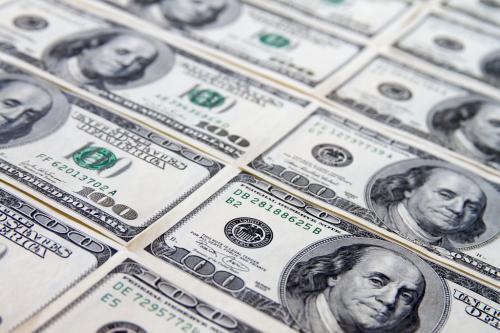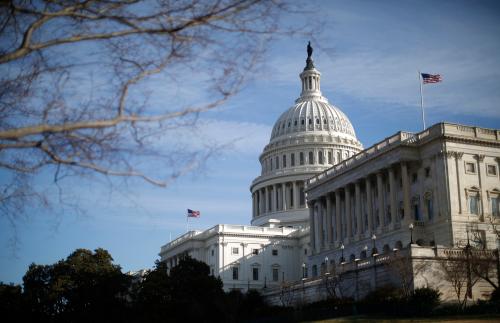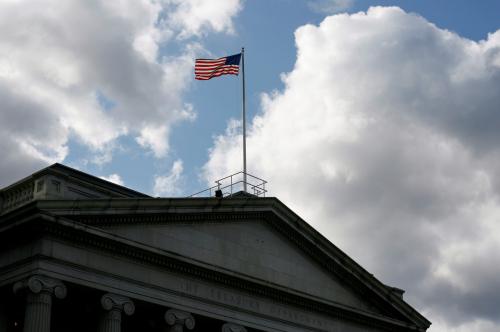This op-ed originally appeared in The Hill on February 23, 2019.
Ten years after hitting rock bottom, the economy is still going strong. But it is never too soon to think about responding to the next recession. The Federal Reserve may be unable to cut interest rates very much in a future downturn because even today rates are within striking range of the zero lower bound. Unfortunately, another key part of the fiscal policy portfolio, which is the automatic response of taxes, will be compromised. Indeed, the 2017 tax cuts will make it more difficult to fight off a future downturn.
The tax system generally works as one way to help stabilize the economy. Taxes naturally rise and fall with income, buffering the effects of economic fluctuations on what workers and firms spend. Moreover, revenues from individual income taxes and corporate income taxes tend to rise or fall by even more than income itself, further moderating booms and cushioning recessions. All of this happens automatically without needing legislation.
The main drivers of these patterns are tax rates, which rise with income, and business profits, which are very sensitive to the economy. Back in 2005, output surged by 3.4 percent, while revenues increased even faster by 11 percent in income taxes and by 42 percent in corporate taxes. In 2009 during the Great Recession, output shrank by 3.4 percent, but individual tax and corporate tax revenues plummeted much further by 21 percent and 55 percent. Keep in mind that changes in tax law do not account for the vast majority of these fiscal fluctuations in the economy.
These patterns notwithstanding, the 2017 tax cuts made several changes that significantly reduce the ability to offset the business cycle. First, the corporate income tax rate was reduced from 35 percent to 21 percent. Corporate income tends to soar in booms and plummet in recessions, so lower rates mean that revenues will not adjust as much to our highs and lows in the economy. The tax cuts also reduced rates for income from wages and pass through businesses. As a result, when income falls in a future recession, taxes will fall by less than they otherwise would have.
Next, the tax cuts limits the use of net operating losses. Under prior law, firms losing money owed no income tax for the current year, and they could obtain cash refunds for taxes paid in the previous two years. Firms used this provision more in recessions than in booms, and it served as an automatic stabilizer. To stimulate the economy after the financial crisis, Congress temporarily expanded the carryback period for net operating losses to five years. The 2017 tax cuts, however, repealed carrybacks of losses for most businesses. As a result, as income turns down in a future recession, firms with losses will no longer be able to claim refunds for previous tax payments and therefore will face tighter cash constraints.
The tax cuts also allowed full first year tax write offs for many investments. Under prior law, when investments fell in a recession, firms still received some depreciation deductions for investments made in previous years, which helped reduce taxes in low investment years. Under the 2017 tax cuts, firms take all the deductions for many investments in the year they are made. When investment falls in a future recession, deductions will fall by more than they did under prior law, while taxes will rise accordingly.
Finally, under prior law, businesses could deduct all interest payments to creditors. The 2017 tax cuts limits this to 30 percent of corporate income before interest, depreciation, and amortization for businesses with gross receipts above $25 million. As a result, when corporate income falls in a future recession, allowable interest deductions will also fall, raising taxes.
The tax cuts will also hamper the ability to fight recessions in other ways. With higher deficits, political leaders will be more reluctant to engage in discretionary stimulus programs to boost the economy. By making some typical instruments, such as expensing, part of the tax code, the tax cuts reduce the number of tools that policymakers can use to fight downturns. A recent paper by two economists with the Joint Committee on Taxation shows that the subsidies for foreign derived intangible income operates in a procyclical fashion by rising during booms and falling during recessions, precisely the opposite of how automatic fiscal stabilization should work.
In one way, it is fitting that the 2017 tax law has poor cyclical properties. Indeed, the deficit financed tax cuts were enacted and implemented at a time when the economy was already doing very well, exactly the opposite of how strong stabilization should work. When the economy eventually turns down, the tax cuts will exacerbate the problem. Policymakers can offset this impact by making stronger discretionary fiscal choices when a recession arrives or by installing stronger automatic stabilizers today.
The Brookings Institution is committed to quality, independence, and impact.
We are supported by a diverse array of funders. In line with our values and policies, each Brookings publication represents the sole views of its author(s).







Commentary
Op-edThe tax cuts will make fighting future recessions complicated
March 8, 2019